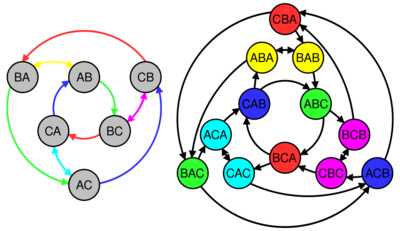Kautz graph
The Kautz graph [math]\displaystyle{ K_M^{N + 1} }[/math] is a directed graph of degree [math]\displaystyle{ M }[/math] and dimension [math]\displaystyle{ N+ 1 }[/math], which has [math]\displaystyle{ (M +1)M^{N} }[/math] vertices labeled by all possible strings [math]\displaystyle{ s_0 \cdots s_N }[/math] of length [math]\displaystyle{ N + 1 }[/math] which are composed of characters [math]\displaystyle{ s_i }[/math] chosen from an alphabet [math]\displaystyle{ A }[/math] containing [math]\displaystyle{ M + 1 }[/math] distinct symbols, subject to the condition that adjacent characters in the string cannot be equal ([math]\displaystyle{ s_i \neq s_{i+ 1} }[/math]).
The Kautz graph [math]\displaystyle{ K_M^{N + 1} }[/math] has [math]\displaystyle{ (M + 1)M^{N + 1} }[/math] edges
[math]\displaystyle{ \{(s_0 s_1 \cdots s_N,s_1 s_2 \cdots s_N s_{N + 1})| \; s_i \in A \; s_i \neq s_{i + 1} \} \, }[/math]
It is natural to label each such edge of [math]\displaystyle{ K_M^{N + 1} }[/math] as [math]\displaystyle{ s_0s_1 \cdots s_{N + 1} }[/math], giving a one-to-one correspondence between edges of the Kautz graph [math]\displaystyle{ K_M^{N + 1} }[/math] and vertices of the Kautz graph [math]\displaystyle{ K_M^{N + 2} }[/math].
Kautz graphs are closely related to De Bruijn graphs.
Properties
- For a fixed degree [math]\displaystyle{ M }[/math] and number of vertices [math]\displaystyle{ V = (M + 1) M^N }[/math], the Kautz graph has the smallest diameter of any possible directed graph with [math]\displaystyle{ V }[/math] vertices and degree [math]\displaystyle{ M }[/math].
- All Kautz graphs have Eulerian cycles. (An Eulerian cycle is one which visits each edge exactly once—This result follows because Kautz graphs have in-degree equal to out-degree for each node)
- All Kautz graphs have a Hamiltonian cycle (This result follows from the correspondence described above between edges of the Kautz graph [math]\displaystyle{ K_M^{N} }[/math] and vertices of the Kautz graph [math]\displaystyle{ K_M^{N + 1} }[/math]; a Hamiltonian cycle on [math]\displaystyle{ K_M^{N + 1} }[/math] is given by an Eulerian cycle on [math]\displaystyle{ K_M^{N} }[/math])
- A degree-[math]\displaystyle{ k }[/math] Kautz graph has [math]\displaystyle{ k }[/math] disjoint paths from any node [math]\displaystyle{ x }[/math] to any other node [math]\displaystyle{ y }[/math].
In computing
The Kautz graph has been used as a network topology for connecting processors in high-performance computing[1] and fault-tolerant computing[2] applications: such a network is known as a Kautz network.
Notes
- ↑ Darcy, Jeff (2007-12-31). "The Kautz Graph". Canned Platypus. http://pl.atyp.us/wordpress/?p=1275.
- ↑ Li, Dongsheng; Xicheng Lu; Jinshu Su (2004). "Graph-Theoretic Analysis of Kautz Topology and DHT Schemes". Wuhan, China: NPC. pp. 308–315. ISBN 3-540-23388-1. https://books.google.com/books?id=DpDwhffRCjwC&q=kautz+graph&pg=PA308. Retrieved 2008-03-05.
 |


